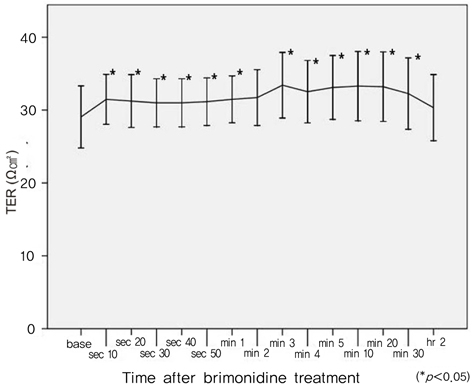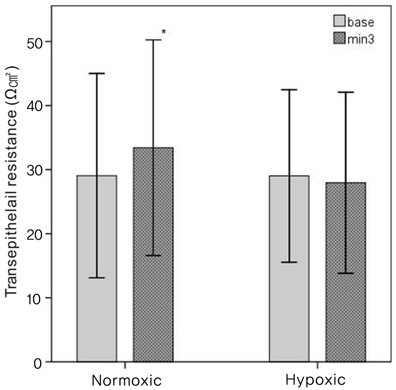Korean J Ophthalmol.
2010 Jun;24(3):169-172. 10.3341/kjo.2010.24.3.169.
The Effect of Brimonidine on Transepithelial Resistance in a Human Retinal Pigment Epithelial Cell Line
- Affiliations
-
- 1Department of Ophthalmology, Seoul Paik Hospital, Inje University College of Medicine, Seoul, Korea.
- 2Department of Physiology, Seoul National University College of Medicine, Seoul, Korea.
- 3Department of Ophthalmology, Seoul National University Hospital, Seoul, Korea. hgonyu@snu.ac.kr
- 4Research Institute of Sensory Organs, Medical Research Center, Seoul National University Hospital, Seoul, Korea.
- KMID: 945988
- DOI: http://doi.org/10.3341/kjo.2010.24.3.169
Abstract
- PURPOSE
To investigate the effects of brimonidine, an alpha-2-adrenergic agonist, on barrier function in ARPE-19 cells by measuring transepithelial resistance (TER). METHODS: ARPE-19 cells were cultured into a confluent monolayer on a microporous filter. Brimonidine was added to the apical medium, and the barrier function of the cells was evaluated by measuring TER. A subset of cells was treated under hypoxic conditions, and the TER changes observed upon administration of brimonidine were compared to those observed in cells in normoxic conditions. RESULTS: The ARPE cell membrane reached a peak resistance of 29.1+/-7.97 Omega cm2 after four weeks of culture. The TER of the cells treated under normoxic conditions increased with brimonidine treatment; however, the TER of the cells treated under hypoxic conditions did not change following the administration of brimonidine. CONCLUSIONS: Barrier function in ARPE-19 cells increased with brimonidine treatment. Understanding the exact mechanism of this barrier function change requires further investigation.
MeSH Terms
Figure
Reference
-
1. Marmor MF. Control of subretinal fluid: experimental and clinical studies. Eye. 1990. 4:340–344.2. Dunn KC, Aotaki-Keen AE, Putkey FR, Hjelmeland LM. ARPE-19, a human retinal pigment epithelial cell line with differentiated properties. Exp Eye Res. 1996. 62:155–169.3. Tian J, Ishibashi K, Handa JT. The expression of native and cultured RPE grown on different matrices. Physiol Genomics. 2004. 17:170–182.4. Geisen P, McColm JR, King BM, Hartnett ME. Characterization of barrier properties and inducible VEGF expression of several types of retinal pigment epithelium in medium-term culture. Curr Eye Res. 2006. 31:739–748.5. Cui HS, Hayasaka S, Zhang XY, et al. Effect of berberine on barrier function in a human retinal pigment epithelial cell line. Jpn J Ophthalmol. 2007. 51:64–67.6. QuinnRH , Quong JN, Miller SS. Adrenergic receptor activated ion transport in human fetal retinal pigment epithelium. Invest Ophthalmol Vis Sci. 2001. 42:255–264.7. Matsuo T, Cynader MS. Localization of alpha-2 adrenergic receptors in the human eye. Ophthalmic Res. 1992. 24:213–219.8. Danylkova NO, Alcala SR, Pomeranz HD, McLoon LK. Neuroprotective effects of brimonidine treatment in a rodent model of ischemic optic neuropathy. Exp Eye Res. 2007. 84:293–301.9. Pederson JE. Ryan SJ, editor. Fluid physiology of the subretinal space. Retina. 2006. 4th ed. Philadelphia: Elsevier/Mosby;1909–1920.10. Bylund DB, Chcko DM. Characterization of alpha2 adrenergic receptor subtypes in human ocular tissue homogenates. Invest Ophthalmol Vis Sci. 1999. 40:2299–2306.11. Diebold Y, Enriquez de Salamanca A, Calonge M, et al. Alpha2-adrenergic receptors are present in normal human conjunctiva. Curr Eye Res. 2005. 30:1121–1129.12. Ma K, Xu L, Zhang H, et al. Effect of brimonidine on retinal ganglion cell survival in an optic nerve crush model. Am J Ophthalmol. 2009. 147:326–331.13. Merin S, Obolensky A, Farber MD, Chowers I. A pilot study of topical treatment with an alpha2-agonist in patients with retinal dystrophies. J Ocul Pharmacol Ther. 2008. 24:80–86.14. Acheampong AA, Shackleton M, John B, et al. Distribution of brimonidine into anterior and posterior tissues of monkey, rabbit, and rat eyes. Drug Metab Dispos. 2002. 30:421–429.15. Kosik-Bogacka D, Mlodzik-Danielewicz N, Banach B, Tyrakowski T. Effect of amiloride and bumetanide on transepithelial ion transport in isolated rabbit cecal and colonic wall. Postepy Hig Med Dosw. 2005. 59:229–235.16. Taub ME, Kristensen L, Frokjaer S. Optimized conditions for MDCK permeability and turbidimetric solubility studies using compounds representative of BCS classes I-IV. Eur J Pharm Sci. 2002. 15:331–340.
- Full Text Links
- Actions
-
Cited
- CITED
-
- Close
- Share
- Similar articles
-
- The Effect of 5-Fluorouraci1 on the Activity of the Retinal Pigment Epithelium in Vitro
- Growth Patterns of Human Retinal Pigment Epithelium in Vitro
- Culture of Retinal Pigment Epithelial Cells on Collagen Membrane
- Extracellular matrix of the human retinal pigment epithelial cells in vitro
- Comparison of Inhibitory Effects of 5-Fluorouracil and Mitomycin C on Proliferation of Fibroblagts and Retinal Pigment Epithelial Cells





